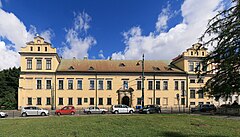Bishop's Palace, Kraków
| Bishop's Palace in Kraków | |
|---|---|

Main façade as seen from ul. Franciszkańska
|
|
|
Palace location in Kraków Old Town (centre-left)
|
The Bishop's Palace in Kraków (Polish: Pałac Biskupi w Krakowie) is the seat of Kraków metropolitan Curia, Poland, and the traditional residence of Kraków bishops since the late 14th century. It is the second largest palace in the city after Wawel – former seat of the Polish monarchs. It is part of a monastery complex of the Franciscan Religious order. Bishop's Palace is best known for being the residence of Pope John Paul II during his stays in the city. He used to give his blessings and talk to his followers from a window above the main entrance at night.
Before the palace was built, the bishopric of Kraków had been located at Wawel since the year 1000, where the remains of earlier buildings still exist. The palace, erected in its present location at ul. Franciszkańska 3 street across from the historic Franciscan Church in Kraków, was mentioned for the first time in the 14th century. It was consumed by fire in 1462 and then rebuilt. The palace was reconstructed with a new staircase and rusticated portals by Bishop Piotr Gembicki in 1642-1647. It was renovated after the Swedish invasion in 1655, and refurbished again in 1817-1820 by Szczepan Humbert. In 1850 a citywide fire burned most of the furnishings and exhibits of national mementoes. Architect Tomasz Pryliński supervised the renovation of the palace in 1881–1884. In spite of its turbulent history including fires and various national calamities such as the Partitions, the palace always served its original purpose.
The palace is a well-preserved example of 19th century architecture, with elements of Polish Renaissance and Baroque decorations including arcaded loggia in the courtyard, added by architect Gabriel Słoński around 1567. The general layout of the palace established by the mid 17th century remains the same despite later renovations.
...
Wikipedia

